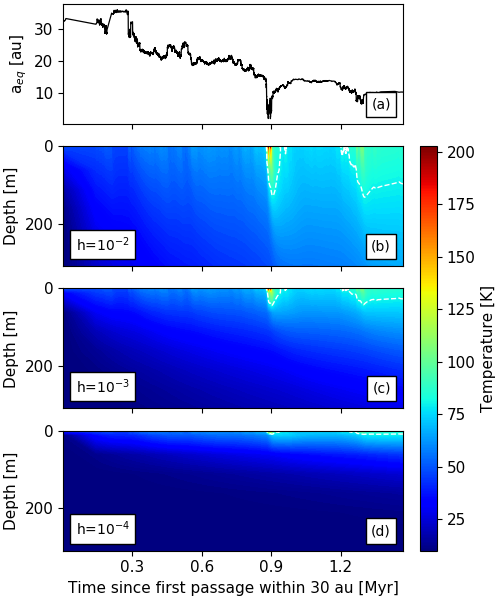On the thermal processing of Jupiter-family Comets
- 1Univ Lyon, UCBL, ENSL, UJM, CNRS, LGL-TPE, F-69622, Villeurbanne, France (anastasios.gkotsinas@univ-lyon1.fr)
- 2Laboratoire d’Astrophysique de Bordeaux, Univ. Bordeaux, CNRS, F-33615 Pessac, France
- 3Department of Space Studies, Southwest Research Institute, 1050 Walnut Street, Suite 300, Boulder, CO 80302, USA
Context
Jupiter-family Comets (JFCs) is a cometary population with a rich evolutionary history. Originating from the Kuiper Belt and the scattered disk, they evolve in the giant-planet region, where they spent a considerable amount of time as Centaurs, before reaching Jupiter-crossing orbits through a series of close encounters with the giant planets [1]. The recent observations of long-distant cometary activity (e.g. [2]), alongside with the existence of active Centaurs [3] suggest the possibility of thermal processing during their journey towards their current positions in the inner solar system. In this study we seek to investigate this potential thermal processing from the moment a comet leaves its reservoir and throughout its evolution in the giant-planet region, until its ejection from the solar system.
Methods
We use a sample of 276 simulated JFCs successfully representing the orbital distribution of JFCs, taken from a N-body simulation tracking the orbital evolution of the giant planets and a large number of small bodies of the outer planetesimal disk [4]. We apply a 1D thermal evolution model [5] on every simulated JFC in order to resolve the heat diffusion equation and obtain the temperature distribution in their interiors. Simplifications are adopted in order to overcome the complexity imposed by the different timescales of the thermal and dynamical processes involved. Special consideration is given to the thermal conductivity, key parameter of the thermal evolution model, to assess its influence in the simulation's results.
Results
The stochastic nature of the trajectories towards the inner solar system results in a pattern of long-lasting periods of heating, randomly spread out over the simulated JFCs lifetimes. As a consequence significant subsurface layers are heated, providing the conditions for substantial alterations to take place. Free condensed hypervolatile species are mostly concerned, as temperatures allowing their sublimation can be found down to the innermost parts of the nucleus in the majority of the objects in our sample. Layers extending several tenths of meters below the surface are also liable to lose primordial condensed moderately-volatile material, while the front of amorphous water-ice is expected to withdraw by a few meters as well.
Perspectives
This study suggests that for any typically observed JFCs, activity is very likely triggered from already processed subsurface layers, indicating the necessity to account for the entire evolutionary history in order to interpret current observations in a broader context.
Acknowledgements
This study is part of a project that has received funding from the European Research Council (ERC) under the European Union’s Horizon 2020 research and innovation programme (Grant agreement No. 802699). We gratefully acknowledge support from the PSMN (Pôle Scientifique de Modélisation Numérique) of the ENS de Lyon for the computing resources.

Example of the temperature distribution for the first 200m below the surface for a simulated JFC, after leaving the Kuiper Belt (panel (a): orbital evolution given by an averaged semimajor axis), for three different values of the thermal conductivity (panels (b) to (d): 5.4 10-3, 5.4 10-4 and 5.410-5 Wm-1K-1) respectively.
How to cite: Gkotsinas, A., Guilbert-Lepoutre, A., Raymond, S., and Nesvorny, D.: On the thermal processing of Jupiter-family Comets, Europlanet Science Congress 2022, Granada, Spain, 18–23 Sep 2022, EPSC2022-201, https://doi.org/10.5194/epsc2022-201, 2022.

